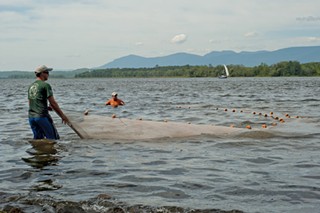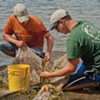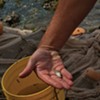Shad are also being stressed by the numerous predators in the river. Some of these fish, such as the smallmouth and largemouth bass, were introduced, upsetting the ecology of the river, which formerly contained far fewer predators of shad and river herring. The development of the Hudson as a sports fishery has hurt the shad, according to the article by Limburg and her colleagues in the Environmental History of the Hudson River.
Marine biologists believe the two most significant causes of decline in recent years are overfishing in the ocean and the invasion of zebra mussels. Ironically, it might have been game-law restrictions on striped bass—one of the few fishes in the North Atlantic to have since made an impressive comeback—that caused many fishermen to switch to shad, depleting the numbers, Hattala says. The ASMFC noted that in 1997, 67 percent of the shad caught were by marine operations, rather than river-based fisheries. While the closing of the marine fisheries has taken off the pressure, ocean by-catch—shad that are accidentally caught in nets targeting other fish—continues to be a serious problem. Fishermen are mandated to report the by-catch, but "they probably don't look closely at the net," says Limburg. Unfortunately, because the number of shad is so low, "any extra deaths now are disproportionately important to the population dynamic," she says.
Zebra mussels, a species of small mussel native to Russia, were transported to America in ship ballast and first showed up in the Hudson River in 1991. Studies by the DEC and the Cary Institute of Ecosystem Studies, based in Millbrook, a decade ago revealed that the mussels had reduced the amount of zooplankton and other tiny animals that serve as food for the juvenile fish by half; phytoplankton, which is eaten by shad larvae, was reduced by 80 percent. David Strayer, senior scientist at the Cary Institute, noted that the amount of food in shallow areas actually increased, benefiting certain fish. But fish that live in the depleted open water would be forced by the lack of food farther down river (zebra mussels only live in freshwater), where they would be more vulnerable to predators.
Strayer says that zebra mussels had completely changed the ecology of the river. "The amount of dissolved oxygen fell by 15 percent and the water got clearer by 50 percent," he says. For unknown reasons, the adult mussels are currently dying off, resulting in areas of recovery. "There are not very many shad and herring in the river anymore, but the little ones are bigger," he says.
He adds that invasive species pose one of the top threats to the river. "There are many more species waiting to arrive in the Hudson," he said. An invasion of the Asian carp, which has reached waterways in Chicago, and if breaching them into the Great Lakes, would eventually enter the Hudson via the Erie Canal, would be particularly devastating, given that it is a voracious eater of plankton. "We need a coherent national policy to deal with the threat," Strayer says.
Sea-level rise is another looming threat. Rising river waters will destroy many of the shallow areas that serve as fish nurseries, Strayer says. Letting the water migrate onto the land so that new shallow areas would be created might help mitigate the loss, but whether humans would allow this, rather than just erecting higher walls, is "not a given."
Some marine biologists attribute the drastic decline of shad to global warming. Shifts in ocean temperatures are believed to be disrupting the food supplies of some fish. Because the shad's migration and spawning patterns are triggered by changes in water temperature—hatching of the eggs, for example, is completely dependent on certain temperatures—shifts in these temperature patterns could wreak havoc on their life cycles.
Chris Nack, son of Garry and a graduate student at SUNY College of Environmental Science and Forestry, has a fellowship with the National Estuarine Research Reserve, located at the DEC's Norrie Point facility in Staatsburgh, to study the fish nurseries in the upper Hudson. He's collecting samples of larval and juvenile shad to learn more about their habitats and diets. Now in its third year and partially funded by Riverkeeper, his research is identifying the variety of shad nursery habitats and pinpointing the most productive, which will help the DEC come up with a restoration plan. He's also found that shad larvae are eating the immature larvae of the zebra mussel—a rather startling discovery, according to Limburg.














